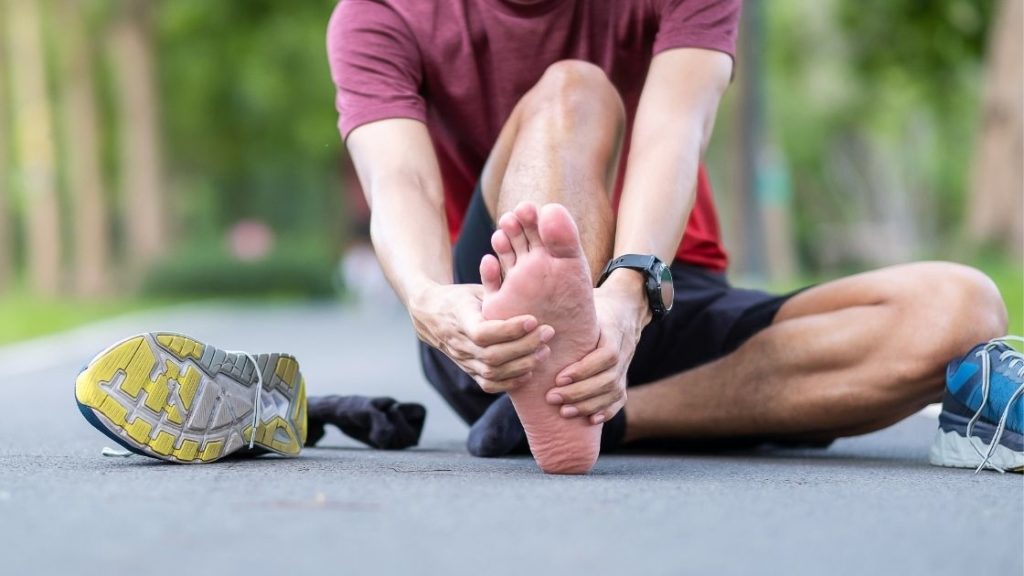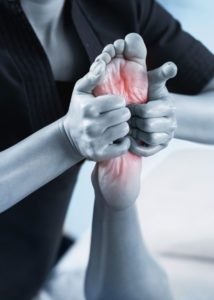Plantar Fasciitis: Our 4-Step Approach to Treating Those at Risk

Plantar fasciitis, one of the most common causes of heel pain, involves the inflammation of the thick band connecting the heel to the toes. For a deeper understanding of what plantar fasciitis entails and how to treat its symptoms at home, I highly recommend reading my previous plantar fasciitis article as well as this special self-massage blog before continuing!
This time around, we’re going to elaborate on the four-step approach at Moyer Total Wellness and how it’s used to address plantar fasciitis symptoms. But first, let’s recap on the signs to look out for and who is at highest risk.
Signs of Plantar Fasciitis
- Pain on the plantar surface (bottom of the foot) on or near the heel.
-
-
- Usually a stabbing pain
- Also common in the arch of the foot
- Tends to be at its worst in the morning, following the first few steps after awakening
-
-
- Intensified pain after working out
-
-
- Emphasis on after as opposed to during exercise
-
-
- Swelling in the heel
- Stiffness and impacted foot mobility
-
-
- Plantar fasciitis leads to tightness in the Achilles tendon, the longest and strongest tendon in your body. It attaches the heel to the calf and makes foot flexion possible.
-
-
Who is at Highest Risk?
Plantar fasciitis is caused by the overuse or over-stretching of the plantar fascia. Who is most likely to repeatedly overuse and over stretch the plantar fascia?
1. Athletes
-
- Runners especially
- Sports and hobbies with prolonged running and frequent jumping put one at risk
-
-
- Basketball, baseball, football, soccer, ballet, aerobic dance
-
-
2. Individuals with High BMI
-
- Excessive pressure places extra strain on the plantar fascial tissue
- High BMI can be attributed to an individual’s amount of muscle mass, bone density, or body fat.
3. Pregnant Women
-
- Women in general are at higher risk for plantar fasciitis than men. Pregnancy, with the gradual weight gain placed on the plantar fascial tissue, puts a woman at even higher risk.
4. People Between the Ages of 40 and 70
-
- Regardless of one’s regular activity level or body type, time can eventually take its toll on the soles of the feet.
5. People With Flat Feet or High Arches
-
- Flat feet are linked to overpronation of the ankle, meaning the foot turns inward when walking. Overpronation over stretches the plantar fascia.
- High arch feet leads to less of the foot touching the ground while walking or running. This means there is less shock absorption upon impact between the foot and the ground, putting the plantar fascia at risk for injury.
Most Effective Bodywork Modalities
The goals of our four-step approach are to remove muscular adhesions, lengthen constricted tissue, strengthen weak muscles, and mobilize the joints.
Myofascial release and deep tissue massage are ideal for removing the adhesions in the feet and calves. Both modalities strip through knotted muscular tissue, relaxing the constricted fibers and making them more pliable. A relaxed and pliable muscle is more compliant when accompanied by the two following modalities:
Assisting stretching is best for strengthening the plantar fascia and mobilizing the foot. Proprioceptive neuromuscular facilitation, or PNF is a form of flexibility training, where the patient passively stretches a muscle group – in the case the tissues in and around the heel – with the assistance of a bodyworker, and then contracts the muscles against resistance.
Pin & stretch techniques can be used to lengthen the plantar fascia. The bodyworker presses onto the muscle’s origin site while the patient’s muscle is contracted, and then glides towards the muscle’s insertion sight while taking the muscle through full range of motion.
The Importance of Diagnosis
Plantar fasciitis can heal on its own, and the recovery time is quicker when treated early.
Ignoring the symptoms for too long can turn a mild inconvenience into a more serious problem. Without early intervention, the symptoms of plantar fasciitis can worsen and significantly impact everyday life. Excessive pain and swelling can lead to limping, and the use of a boot or a cast might be in order to restore one’s mobility. Some cases become so severe they end up requiring surgery.
Now You Know!
Be aware of the signs of plantar fasciitis, especially if you fall into the high risk category. Plantar fasciitis is treatable and our therapists are here to guide you through the recovery journey!

Katrina Jenkins
Author, Licensed Massage Therapist
Katrina Jenkins graduated from Towson University in 2013 with a Bachelor’s Degree in Health Science and worked as a nurse’s aide briefly before pursuing her true passion. She graduated from the Massage Therapy Institute of Colorado in April 2016 with honors and completed the Touch of Healers Scholarship Program the following summer. She has been a part of the Moyer Total Wellness Team since the summer of 2017.
Resources
Buchanan, B.K. and Kushner, D. (2020). Plantar Fasciitis. [online] PubMed. Available at: https://www.ncbi.nlm.nih.gov/books/NBK431073/.
Lim, A., How, C. and Tan, B. (2016). Management of plantar fasciitis in the outpatient setting. Singapore Medical Journal, [online] 57(04), pp.168–171. Available at: https://www.ncbi.nlm.nih.gov/pmc/articles/PMC4853481/.
Park, S.-Y., Bang, H.-S. and Park, D.-J. (2018). Potential for foot dysfunction and plantar fasciitis according to the shape of the foot arch in young adults. Journal of Exercise Rehabilitation, [online] 14(3), pp.497–502. Available at: https://www.ncbi.nlm.nih.gov/pmc/articles/PMC6028224/.
Sissons, C. (2019). Plantar fasciitis: Causes, symptoms, risk factors, and remedies. [online] www.medicalnewstoday.com. Available at: https://www.medicalnewstoday.com/articles/326641.
Photo Credit
Canva by Panuwat Dangsungnoen
Canva by microgen

